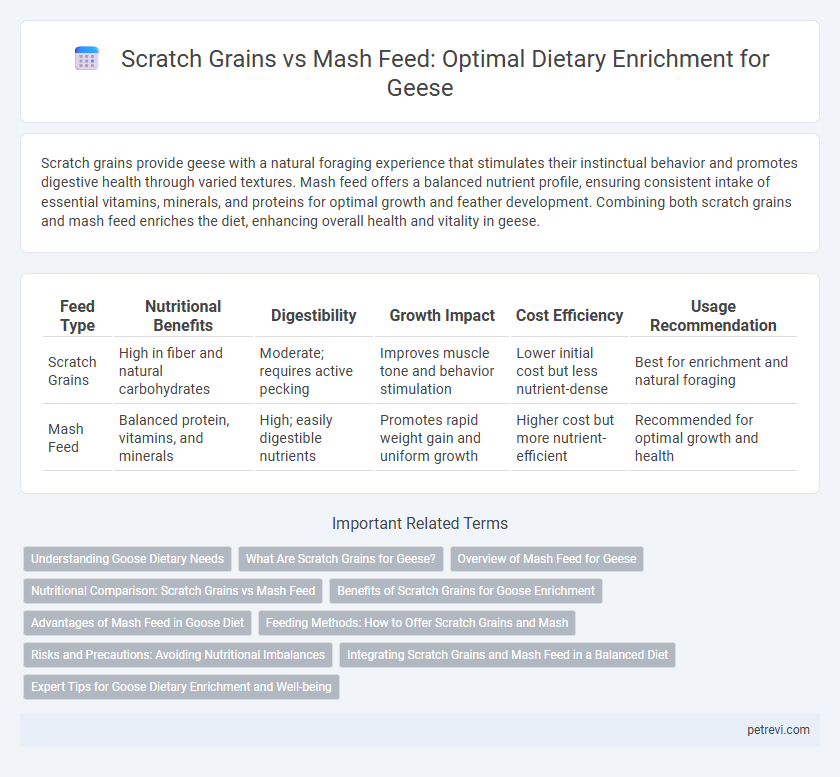Scratch grains provide geese with a natural foraging experience that stimulates their instinctual behavior and promotes digestive health through varied textures. Mash feed offers a balanced nutrient profile, ensuring consistent intake of essential vitamins, minerals, and proteins for optimal growth and feather development. Combining both scratch grains and mash feed enriches the diet, enhancing overall health and vitality in geese.
Table of Comparison
| Feed Type | Nutritional Benefits | Digestibility | Growth Impact | Cost Efficiency | Usage Recommendation |
|---|---|---|---|---|---|
| Scratch Grains | High in fiber and natural carbohydrates | Moderate; requires active pecking | Improves muscle tone and behavior stimulation | Lower initial cost but less nutrient-dense | Best for enrichment and natural foraging |
| Mash Feed | Balanced protein, vitamins, and minerals | High; easily digestible nutrients | Promotes rapid weight gain and uniform growth | Higher cost but more nutrient-efficient | Recommended for optimal growth and health |
Understanding Goose Dietary Needs
Scratch grains provide geese with essential fiber and promote natural foraging behavior, enhancing digestive health through increased gut motility. Mash feed offers a balanced blend of vitamins, minerals, and proteins tailored to support optimal growth, feather development, and egg production in geese. Combining scratch grains with mash feed ensures dietary enrichment that meets the species-specific nutritional requirements of goslings and adult geese.
What Are Scratch Grains for Geese?
Scratch grains for geese consist of small, loose grains like cracked corn, wheat, and oats that encourage natural foraging behaviors and provide essential nutrients. These grains are scattered on the ground, promoting activity and mental stimulation while supplementing a goose's diet with carbohydrates and fiber. Unlike mash feed, which is a balanced, ground feed blend, scratch grains offer less nutritional completeness but are valuable for dietary enrichment and digestive health.
Overview of Mash Feed for Geese
Mash feed for geese offers a balanced blend of grains, vitamins, and minerals that promote optimal growth and health. Unlike scratch grains, mash feed ensures uniform nutrient intake by combining protein sources, fiber, and essential micronutrients in a finely ground form. This carefully formulated diet enhances digestion, boosts immune response, and supports egg production in domestic geese.
Nutritional Comparison: Scratch Grains vs Mash Feed
Scratch grains for geese provide a high-fiber diet rich in carbohydrates that promote natural foraging behavior and improve digestive health. Mash feed offers a balanced nutrient profile with essential proteins, vitamins, and minerals, supporting optimal growth and immune function. Comparing both, mash feed ensures consistent nutrient intake whereas scratch grains enhance gut motility and mental stimulation.
Benefits of Scratch Grains for Goose Enrichment
Scratch grains provide geese with natural foraging behaviors that stimulate mental engagement and physical activity, enhancing overall well-being. These grains improve digestive health by promoting gut motility through increased chewing and natural grain variety compared to mash feed. Incorporating scratch grains into a goose's diet supports nutrient diversity and prevents boredom, leading to healthier, more active birds.
Advantages of Mash Feed in Goose Diet
Mash feed provides a balanced and homogenous mixture of essential nutrients that support optimal growth and overall health in geese. The uniform consistency of mash feed enhances digestibility and nutrient absorption compared to scratch grains, which can lead to selective feeding and nutrient imbalances. Incorporating mash feed in goose diets improves feed efficiency and ensures consistent intake of vitamins, minerals, and proteins critical for development and productivity.
Feeding Methods: How to Offer Scratch Grains and Mash
Scratch grains for geese should be scattered on the ground to encourage natural foraging behavior, promoting physical activity and mental stimulation. Mash feed can be offered in shallow trays or feeders, ensuring easy access and reducing waste while providing a balanced nutrient profile. Combining both methods supports dietary enrichment by mimicking varied feeding patterns and enhancing overall goose health.
Risks and Precautions: Avoiding Nutritional Imbalances
Feeding geese scratch grains can lead to nutritional imbalances due to their high carbohydrate content and low protein levels, increasing the risk of obesity and vitamin deficiencies. Mash feed, formulated to provide a balanced mix of essential nutrients including proteins, vitamins, and minerals, minimizes these risks and supports optimal growth and health. Careful monitoring of feed type and quantity is essential to prevent digestive issues and ensure a well-rounded diet for geese.
Integrating Scratch Grains and Mash Feed in a Balanced Diet
Integrating scratch grains and mash feed in a balanced diet enhances nutrient intake and supports optimal growth in geese. Scratch grains provide essential fiber and encourage natural foraging behavior, while mash feed delivers a concentrated source of vitamins, minerals, and proteins crucial for maintenance and development. Combining these feeds ensures a diversified diet that promotes gut health, stimulates appetite, and improves overall feed efficiency in geese.
Expert Tips for Goose Dietary Enrichment and Well-being
Scratch grains and mash feed play crucial roles in goose dietary enrichment by promoting natural foraging behaviors and providing balanced nutrition. Experts recommend offering scratch grains to stimulate activity and mental engagement, while mash feed delivers essential vitamins, minerals, and protein for optimal growth and immune support. Combining these feeds according to the goose's age, health, and productivity maximizes overall well-being and enhances digestive health.
Scratch grains vs Mash feed for Goose dietary enrichment Infographic

 petrevi.com
petrevi.com